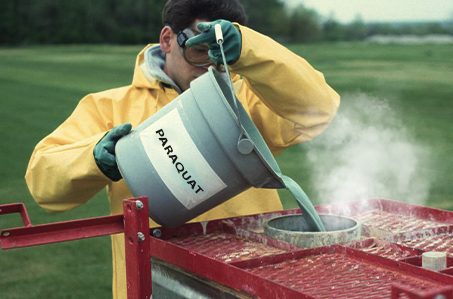Raleigh, NC: (919) 277-9299

It’s unknown what amount, route, or duration of paraquat exposure causes Parkinson’s disease, but no pathway is exempt from creating a toxic reaction. It’s suggested that even minimal contact with these hazardous herbicides can cause Parkinson’s disease.
Agricultural workers may be exposed to toxic paraquat-dichloride chemicals when mixing herbicides, spraying crops, and cleaning application equipment. Contaminated surfaces, field dust, and containers can also be sources of direct and indirect contact. Farmers, vineyard workers, commercial landscapers, and people living near herbicide-treated agricultural fields should be aware of, and avoid, paraquat exposure sources.
Paraquat Exposure From Inhalation
Spraying is a common application method for paraquat and a frequent route of exposure for farm workers. Diseases caused by paraquat result when inhaled toxins accumulate in organs and cause epigenetic or neurological changes. Research on mice showed inhaling paraquat causes changes in the brain, and the rodents displayed a loss of smell, a precursor to Parkinson’s disease. The olfactory system is especially susceptible to mist from a sprayer or fumes from the concentrate and offers the chemicals a direct route to the brain.
Dermal Exposure to Paraquat
Loading and mixing herbicides containing paraquat-dichloride-containing chemicals often causes the greatest risk of exposure, especially before the concentrates are diluted or when these tasks result in direct contact with the chemicals. Cleaning application tools, and entering paraquat herbicide-treated fields are other actions that increase people’s risk of dermal exposure. A splash or spray of an herbicide on the skin may seem harmless but researchers warn that after repeated contact, paraquat can cause diseases like Parkinson’s.
The Effects of Hazardous Herbicides
Parkinson’s disease is among the most devastating conditions caused by paraquat-dichloride containing herbicides. The fast absorption rate and cumulative nature of paraquat make a dangerous combination. Absorbing paraquat through any exposure pathway can potentially change neurons and drop a person’s dopamine levels. When this occurs, the brain’s message center slows and the person exhibits signs of Parkinson’s disease, including uncoordinated movements, tremors, trouble communicating, and body rigidity.
Despite the alarming potential association between paraquat and Parkinson’s disease, the herbicide remains in widespread commercial use in the U.S. Instead of addressing safety concerns about paraquat, its manufacturers have spent decades refuting scientific research and influencing messaging to keep harmful paraquat-dichloride containing products on the market.
While farmers today wear personal protective equipment (PPE) when handling toxic herbicides like paraquat, this wasn’t always the case. After paraquat was nearly banned in the 1970s, manufacturers manipulated public opinion by adding ‘safety features’ which likely led farmers to believe exposure was harmless. After a rash of Parkinson’s diagnoses and a pattern of motor issues amongst paraquat users, it’s getting harder for those profiting off the chemicals to deny the connection, and advocates again urge Congress for a ban. The lawsuit against paraquat manufacturers has unearthed countless documents from staff scientists confirming these companies understood paraquat isn’t only the most-used herbicide, it is also one of the most dangerous.
